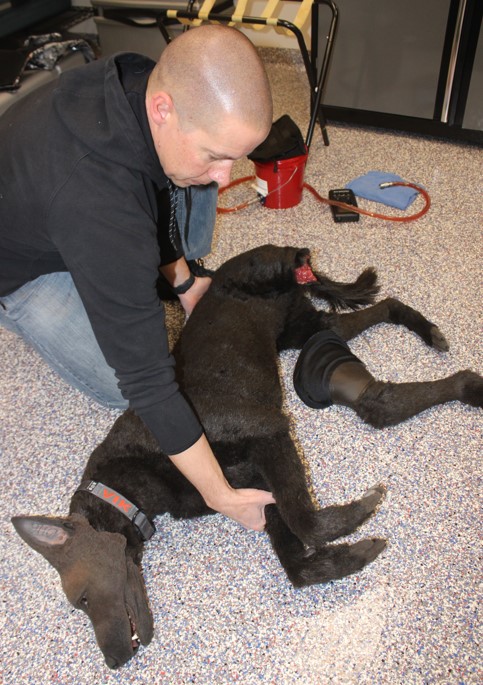(Valparaiso, IN) - Emergency responders throughout the region were taught how to give medical treatment to police dogs wounded or harmed in the line of duty. A three-day training session wrapped up on February 16 at the Multi-Agency Academic Cooperative in Valparaiso.
Todd Konrady, a tactical medicine teacher at MAAC, said the training responds to a new state law allowing public safety dogs to be treated out in the field and transported to a local animal clinic.
“We want to be able to take care of them just as much as we can as our own fellow human first responders,” Konrady said.
The training sessions were led by Dr. Lee Palmer, Director of Medical Education at PennVet Working Dog Center at the University of Pennsylvania. Palmer also provided instruction on medical care for canines in the military.
During his training, one of the focuses was treating canines exposed to heroin and other narcotic powders during vehicle searches. The antidote, Naloxone, should be administered through the nostrils and a muzzle placed on the dog to keep medical providers from potentially getting bit once the animal wakes up.
Palmer said the dog should also be intubated by inserting a tube fastened to a bag down the animal’s throat. The bag is squeezed repeatedly to breathe for the dog until the animal is out of danger.
The bag is squeezed repeatedly to breathe for the dog until the animal is out of danger.
“Nothing is more life-saving than oxygen until the naloxone takes effect,” Palmer said.
The training also provided guidance on treating gunshot wounds, broken legs, and other conditions like heat stroke.
Heatstroke is a leading cause of harm for canine dogs followed by hemorrhaging from gunshots, stabbings, and contact with other sharp objects, said Lyn Schuh, co-founder of the Operational Canine Medical Team of Wisconsin. Her group trains emergency responders throughout Wisconsin in providing medical care for police dogs out in the field.
“If they’re two miles out tracking a bad guy, they need to know what they can do right there,” Schuh said.
Schuh said the payback is not having to replace a dog, costing thousands of dollars to purchase and train, and sparing grief for handlers of dogs they care for at home and become emotionally attached.
Konrady said handlers also learned about the early signs of heatstroke to order the dogs to stop before their condition becomes severe.
“The dogs have such a work drive they’ll keep going until they collapse,” Konrady said.
Most of the life-saving procedures were practiced on a robotic dog belonging to MAAC, which is in the process of forming its own canine tactical medicine training program. A remote control allows the dog to bleed and quit bleeding from life-like wounds in its fur-covered rubber hide and breathe at different rates while treatment is being applied.
“There’s a lot of stuff we can do with this dog,” Konrady said.
A live dog was used to practice things like bandaging.
C.C. Ditchcreek, a firefighter and paramedic in Hobart, said she would be able to apply what she learned to a dog being trained to detect gasoline and various other accelerants in potential cases of arson. She knows the signs of heatstroke and smoke inhalation in dogs now and how to treat burns on the paw pads of dogs working the scene of a still-smoldering fire.
“This class was super informational about that,” Ditchcreek said.
Schuh said treating dogs is similar but different from humans and emergency responders, and their handlers are usually not trained to provide them with medical care. For example, she said the four-legged animals don’t have wrists like humans for checking the pulse. Instead, the heart rate in dogs is detected under the thigh of the right-back leg where the main artery exists. Medical providers on dogs also have to take different angles when applying treatment.
“Dogs don’t stand up like humans, so things are positioned differently,” Schuh said.
Among the pieces of advice from Palmer to his students was to be prepared as much as possible.
“It’s better to make mistakes in training than making mistakes in real life,” Palmer said.





